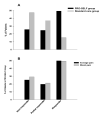The use of a responder analysis to identify differences in patient outcomes following a self-care intervention to improve cancer pain management
- PMID: 17257753
- PMCID: PMC1906700
- DOI: 10.1016/j.pain.2006.09.031
The use of a responder analysis to identify differences in patient outcomes following a self-care intervention to improve cancer pain management
Abstract
Previously, we demonstrated, in a randomized clinical trial, the effectiveness of a psychoeducational intervention to decrease pain intensity scores and increase patients' knowledge of cancer pain management with a sample of oncology patients with pain from bone metastasis. In the present study, we evaluated for changes in mood states (measured using the Profile of Mood States), quality of life (QOL; measured using the Medical Outcomes Study Short Form-36 (SF-36)), and pain's level of interference with function (measured using the Brief Pain Inventory (BPI)) from baseline to the end of the intervention first between the intervention and the standard care groups and then within the intervention group based on the patients' level of response to the intervention (i.e., patients were classified as non-responders, partial responders, or responders). No differences were found in any of these outcome measures between patients in the standard care and intervention groups. However, when patients in the intervention group were categorized using a responder analysis approach, significant differences in the various outcome measures were found among the three respondent groups. Differences in the physical and mental component summary scores on the SF-36 and the interference items on the BPI, among the three respondent groups, were not only statistically significant but also clinically significant. The use of responder analysis in analgesic trials may help to identify unique subgroups of patients and lead to the development of more effective psychoeducational interventions.
Figures

References
-
- Ahles TA, Ruckdeschel JC, Blanchard EB. Cancer-related pain--I. Prevalence in an outpatient setting as a function of stage of disease and type of cancer. J Psychosom Res. 1984;28(2):115–119. - PubMed
-
- Allard P, Maunsell E, Labbe J, Dorval M. Educational interventions to improve cancer pain control: a systematic review. J Palliat Med. 2001;4(2):191–203. - PubMed
-
- Avorn J, Soumerai SB. Improving drug-therapy decisions through educational outreach. A randomized controlled trial of academically based “detailing”. N Engl J Med. 1983;308(24):1457–1463. - PubMed
-
- Baker F, Denniston M, Zabora J, Polland A, Dudley WN. A POMS short form for cancer patients: psychometric and structural evaluation. Psychooncology. 2002;11(4):273–281. - PubMed
-
- Burrows M, Dibble SL, Miaskowski C. Differences in outcomes among patients experiencing different types of cancer-related pain. Oncol Nurs Forum. 1998;25(4):735–741. - PubMed
Publication types
MeSH terms
Grants and funding
LinkOut - more resources
Full Text Sources
Medical

